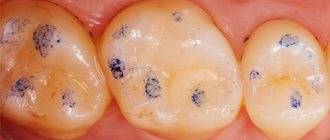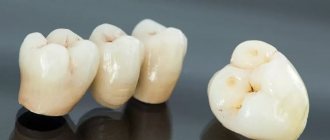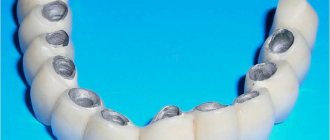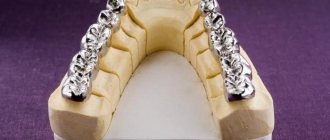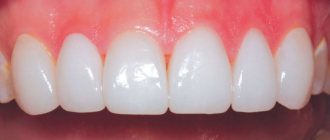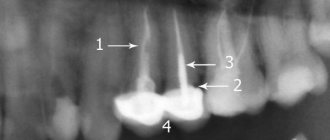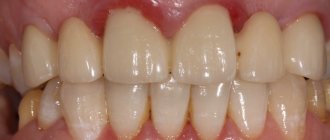E.max Press ceramics can be used to represent various dental objects: veneers, crowns, onlays and inlays. What material the inlays are made from is decided by the dentist himself.
Application area
The scope of application of E.max Press ceramic inlays is extensive. The ceramic inlay is used from conventional prosthetics to the installation of onlays on teeth for their impeccable beauty (Lumineers).
The inlay contains zirconium oxide, which is used to create more durable structures, for example, to restore the anatomical integrity of teeth, and lithium disilicate is used for lighter structures (for example, to restore anterior teeth). It also contains glass ceramics and leucite crystals, which increases the overall strength of the structure.
The E.max ceramic inlay has been used for a long time for the manufacture of this type of structure:
- Veneers and lumineers. Previously, veneers were made from photopolymers, but their short service life forced modern dentists to abandon them. Metal-free veneers are more beautiful and durable.
- Crowns: a classic dental element that has found a new life with E.max. For front teeth, this is the best solution compared to metal-ceramics.
- Inlays: an alternative to photopolymers, which tend to wear out over time. Made under special conditions, ceramic inlays are more durable and less susceptible to abrasion. An exception for E.max is the impossibility of installing long bridges.
An aesthetic smile has always attracted people. Modern dentistry uses every opportunity and means to improve the external characteristics of the dentition.
The appearance of the E.max Press ceramic inlay on the market about 20 years ago exploded the dental market, because it was truly a major breakthrough. Previously, metal-ceramic inserts were used, which were harmful to the patient’s oral cavity.
Summary -
E-max will be the best choice –
- single crowns (regardless of location),
- 3-unit bridges for the front teeth,
- veneers,
- lumineers (thickness from only 0.3 mm),
- if the patient has high aesthetic requirements,
- if the patient has high transparency of tooth enamel.
Zirconium would be the best choice –
- bridges on chewing teeth,
- bridges of 4 or more units,
- single crown supported by an implant,
- bridge prosthesis supported by implants,
- if the patient has bruxism.
Advantages
Experts emphasize the following advantages of the design:
- Extensive experience in using ceramic liners all over the world. More than 30 million restorations have been registered.
- High structural strength. This is due to the fact that when creating liners, a pressing method is used, which guarantees the hardness and uniformity of the material.
- Aesthetics. Crowns and lumineers allow dentists to fine-tune transparency, color, and highlights to achieve maximum naturalness.
- A light weight. The patient quickly gets used to the feeling of something new on the teeth.
- Anti-allergic composition. Allergy sufferers are very lucky. E.max Press has excellent biocompatibility with the human body, so patients do not have to worry about possible allergic reactions.
- Reliability. This design lasts for many years.
Making crowns from pressed ceramics
To create such crowns, ceramics are sintered in a vacuum at elevated temperatures, which gives structures made from it high strength. When working with it, it is extremely important to follow absolutely all technological instructions, otherwise failure to comply with them can lead to damage to the products - they will have to be remade and restored.
That is why the skill of the dental technician and the equipment of the denture laboratory come to the fore. At the Denta-Labor clinic, dental technicians undergo regular training and certification in working with new materials. When you turn to us for services, you can be calm and confident that the work will be done efficiently and in a timely manner, and the result will please you for a long time.
Indications for use
E.max Press shown:
- for creating ceramic crowns;
- for restoration of tooth enamel and teeth;
- for installation of implants;
- to eliminate dental defects (gaps between teeth);
The design also has contraindications:
- Parafunctions of the jaw (bruxism); presence of bad habits (biting nails, opening various objects with teeth, etc.);
- fluorosis (excess fluoride, which results in yellowing of the teeth);
- any other orthopedic structures in the oral cavity (they block the installation of e.max ceramics (bracket system, retainer)).
Stages
Metal-free ceramics is a modern approach to dental prosthetics, which is produced quite quickly (in 2 - 3 days).
Stages of manufacturing metal-free ceramic structures:
- Preparing teeth for prosthetics: treatment, preparation.
- Obtaining an optical impression of the prepared tooth and antagonist teeth.
- Determining the color of the future structure.
- Digital modeling of the frame of the future prosthesis.
- Turning the frame of a structure from zirconium dioxide on a milling machine.
- Applying ceramic mass to the frame. Firing in a kiln.
- Try-on in the patient's mouth.
- Fixation of metal-free ceramics with permanent cement.
Planning and installation steps for E.max
To avoid unexpected adverse consequences, before installing the E.max tab, an accurate diagnosis is carried out and the presence of all kinds of contraindications is identified. Clinicians may use a facebow, articulators, or wax-up/computer sculpting for structures that are temporary. In severe cases, patients are prescribed axiography.
Experts distinguish several successive phases of prosthetics:
- First, a cast of the jaw that needs restoration is made. After this, a tooth of the desired shape is modeled using wax on this model. The external appearance of the source copy reproduces the natural version as accurately as possible.
- The doctor, based on tests, examination and examination of the oral cavity, determines which design is required in a particular case (crown, veneer, or solid tooth). The material is placed in a specially designed oven, where a ceramic blank is added.
- After completing the process of preparing the blank, the dental technician adjusts the model for the patient.
- Dental glaze is applied to the finished structure so that the teeth take on the natural color of the enamel. This process will be carried out in the dental office so that the doctor can assess the condition of the workpiece.
- The end of the procedure is the creation of reliable fastenings to the structure. If necessary, correction can be made.
- Securing the finished denture in your mouth.
The developers of E.max Press approached the fixation process with all responsibility. There are traditional, adhesive and self-adhesive fastening methods. There is also a huge selection of dental composite adhesives to choose the best option for each patient individually.
Why ceramics
The term "ceramics" translated from ancient Greek means pottery clay. At the chemical level, clay is an aluminum silicate with an amorphous structure. The properties of ceramics after firing make them extremely durable, and therefore attempts to use them in dentistry began two centuries ago.
However, serious advances in the use of ceramics were achieved relatively recently and were caused by a thorough study of the chemical properties of this material. It is ceramics that has the most significant similarity in both strength and optical properties with natural teeth, which has attracted increased interest from dentists.
As a material for the manufacture of restorations such as veneers, inlays or crowns, ceramics, including
pressed ceramics , can offer the optimal combination of functionality and aesthetic characteristics.
The basis of work in the manufacture of restorations is modeling. To do this, impressions of the patient’s jaws are made, on the basis of which a wax model is created and the appearance of future restorations is formed. The finished ceramic blank is placed in a press, where the ceramic is pressed under high pressure and receives its characteristics. After this, the finished structure is placed in a kiln and fired, as a result of which it receives its finished appearance and properties.
Possible complications
E.max ceramics are an absolutely gentle material, which in rare cases can cause some problems. Complications may include:
- Color discrepancy (if the manufacturing process was disrupted);
- Noticeable edge fit (indirect effect, when the structure can be easily distinguished from natural enamel by a noticeable colored rim);
- Irregular tooth shape (most often found on the front of the incisors);
- inflammation of the gums or inner layers of the tooth.
To avoid these problems, the specialist who installed the structure should consult with the patient’s attending dentist.
Pressed ceramic crowns
This type of crown does not have a metal frame. They are stronger than their composite counterparts. The product is fixed using a special material, so the final result looks very attractive and aesthetically pleasing. It is possible to choose ceramics that will match the color of the surrounding teeth tone-on-tone, so that it will be almost impossible to distinguish the design from them.
During the creation of one artificial tooth, seven to nine different shades of ceramic can be used to match the desired shade. The crown replicates not only the color, but also the shape of natural teeth.
Crowns made from this material are indicated in the following cases:
- severe tooth decay,
- the need for aesthetic correction of the tooth shape,
- the need for a bridge structure in the absence of one tooth,
- correction of front or side teeth.
The products have a service life of 5-7 years, which can be increased if the structures are properly cared for.
How are ceramic crowns placed?
Installing a ceramic crown involves the following steps.
- Preparation. The patient undergoes a visual examination, X-ray diagnostics, canal treatment and gentle grinding of the tooth - the specialist removes much less dental tissue than for crowns made of other materials. An additional advantage is that removal of the nerve is not a prerequisite for attaching a ceramic prosthesis.
- Making a ceramic crown. The doctor takes impressions of the jaws and sends them, along with x-rays, to the laboratory, where a plaster model is made to create an orthopedic structure using one of two technologies:
- hot pressing with layer-by-layer application of ceramics;
- computer modeling CAD/CAM and milling.
If the tooth tissue is severely damaged and there is no reliable base for the prosthesis, a stump inlay is first placed under a ceramic crown. More recently, under similar circumstances, a ceramic crown was installed on a pin, but today the method is outdated and is practically not used in clinics.
- Fixation of a ceramic crown. The procedure is carried out using a special cement or primer, which is polymerized by light. A ceramic crown, like any other, can be placed correctly only by an experienced orthopedist. Poor quality prosthetics leads to inflammatory processes in the gum tissue, tooth destruction and loss of the structure.
approximate cost
The price consists of the cost of the dentist and orthopedist, taking impressions, processing the enamel, manufacturing and installing the structure. The technology for creating a prosthesis is also important. In some clinics, this recovery option can cost 20,000 rubles, while in others the price will exceed 50,000 and even 100,000 rubles.
Prosthetics with ceramic microprostheses has virtually no disadvantages. The exception is some contraindications and high cost. By consulting with your dentist, you can make the best decision by weighing the pros and cons.
Veneer care
Veneers of any variety, be it ceramic, porcelain, or others, require the same care as natural teeth. But there are additional recommendations for maintaining the aesthetic appearance and extending the service life of the onlays, namely: reducing the consumption of food with dyes, as there is a risk that the bonding cement may change its shade; do not expose teeth with onlays to increased stress to avoid peeling off or damaging the onlays and conduct preventive examinations at a dental clinic every six months.
Service life and care rules
Ceramic structures are fixed with an adhesive material that collapses only after 10 or more years. For comparison: metal ceramics are attached with glue, which becomes unusable after 5-6 years.
The service life of a ceramic prosthesis can be easily extended, since even if a chip appears, it is possible to restore the microprosthesis. But breakdowns are extremely rare, since ceramics can withstand the required chewing load well.
If chipping could not be avoided, there are two options for solving the problem:
- Complete replacement of the structure. The crown is removed from the mouth, and prosthetics are repeated from start to finish.
- Restoration. In case of minor chipping, a light-curing material is placed into the formed cavity. After it hardens, the dentist can create the necessary shape of the crown, repeating the fissures and tubercles. The final stage of the restoration will be grinding to the desired size.
The causes of failure can be injuries, inaccuracies in the work of the dental technician, incorrect bite, or strong mechanical impact on the microprosthesis. For the patient, the best option would be restoration, as it is cheaper and faster.
Porcelain on posterior molars
As for care, it does not differ from the standard one. You need to clean artificial dentures no less carefully than you clean your own teeth. To prevent problems with the gums and roots, dentists recommend using fluoride-containing paste. You need to visit a doctor after prosthetics at least twice a year.
Contraindications for installation of press ceramics
- Inflammation in the oral cavity.
- Malocclusion.
- Involuntary grinding of teeth.
- Complete absence or absence of a large number of chewing teeth.
- Severe osteoporosis.
- Acute forms of systemic diseases of the body. At such times, it is better not to subject the body to additional stress, and press ceramics requires professional preparation of the oral cavity, which includes sanitation, grinding of teeth and other dental procedures that cause additional stress for a person.
- Pregnancy. Often, when installing crowns, the use of painkillers is required, and this can harm the expectant mother and her baby.
